People
Artist Duo Jakob Lena Knebl and Ashley Hans Scheirl Make Instagram-Friendly Installations That They Hope Will Start a Social Revolution
The duo is representing Austria at the Venice Biennale.
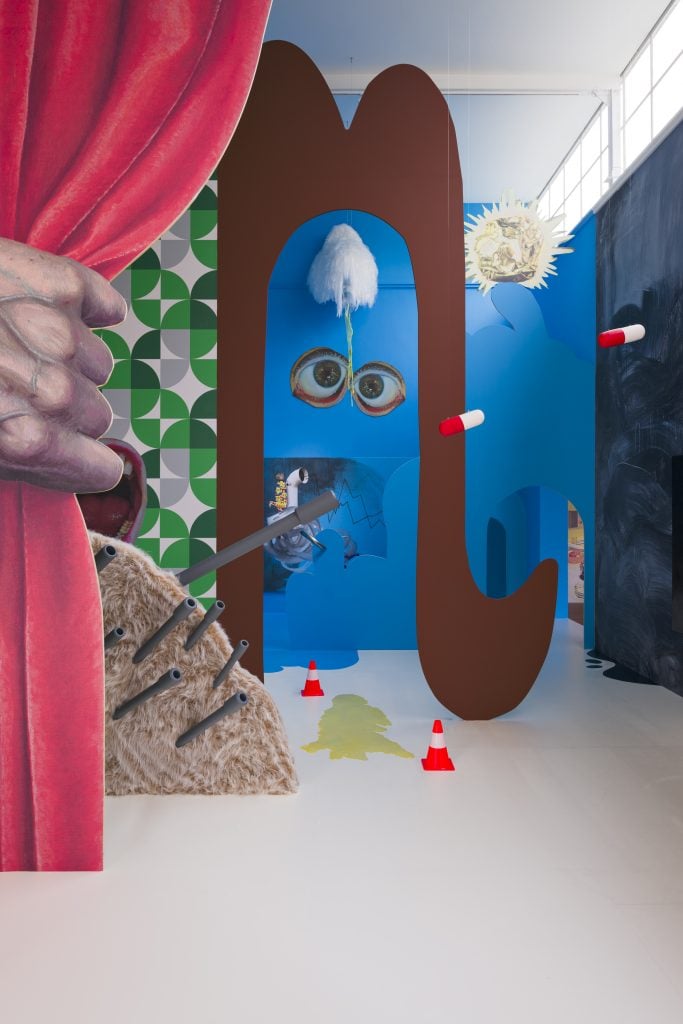
The duo is representing Austria at the Venice Biennale.

Naomi Rea

I was power-walking through the Giardini at the Venice Biennale when a coarse laugh emanating from a fluffy lilac ensemble lured me off piste. I was drawn towards a huddle outside the Austrian pavilion, where artist duo Ashley Hans Sheirl and Jakob Lena Knebl, who have been selected to represent the country at the prestigious international event, were holding court next to their colorful multimedia installation.
Inside, there were several visitors posing for photographs with the art. But their immediate focus on the display over the content of the exhibit didn’t bother the artists, who were happy enough to strike poses for the paparazzi. Both work with students in Vienna —Sheirl lectures in contextual painting at the Academy of Fine Arts, and Knebl teaches transmedia art at University of Applied Arts—and they understand the function of an appealing exterior. “The biggest compliment for me is when someone says ‘I want to move in,’” Knebl told me. “I love this idea. We are working with seduction and the power of aesthetics to transport challenging topics.”
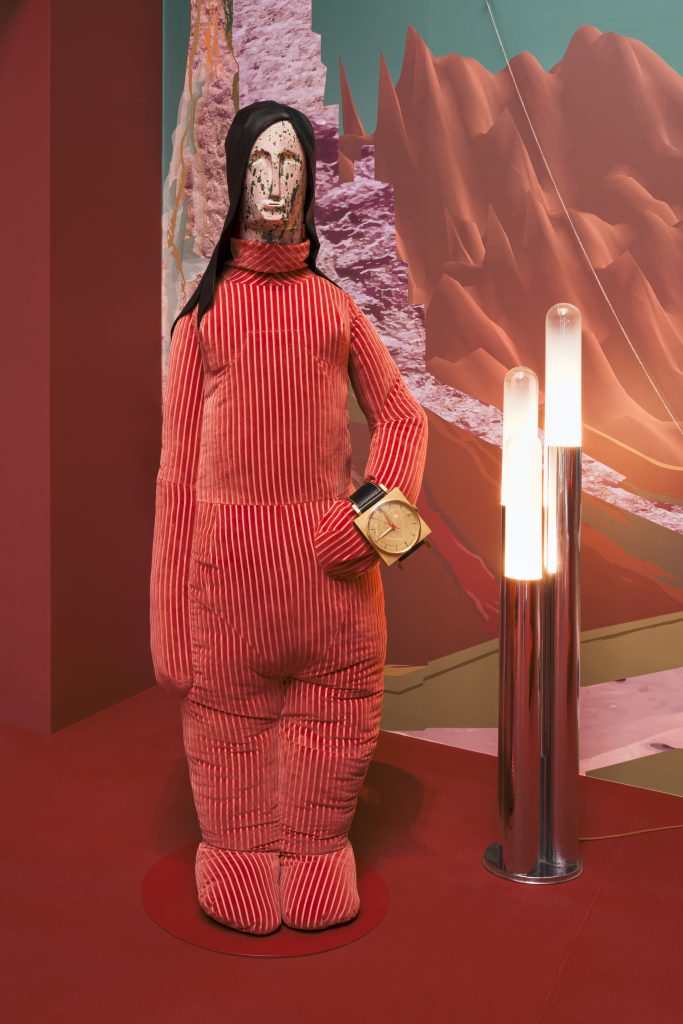
Installation view, Austrian Pavilion Biennale Arte 2022. Photo: Georg Petermichl; ©Jakob Lena Knebl and Ashley Hans Sheirl.
For their takeover of the pavilion, titled “Invitation of the Soft Machine and Her Angry Body Parts”, the artists have made use of the structure’s symmetrical architecture to split it down the middle. Each has mounted complementary installations of their solo works in either wing.
“We are working as solo artists as well as a duo,” Knebl had informed me earlier, as she spoke in between cigarette puffs on a Zoom meeting in advance of the opening. “What is crucial is the dialogue, the dynamic between the two quite different practices.” By way of explaining their approach, she gestured towards the work of psychologist Martin Buber, who wrote: “We become an ‘I’ through the ‘you.'”
I kind of felt like I was talking to the caterpillar in Alice in Wonderland. You need to be able to keep up with the esoteric references wafting through the air—which span from Jean-François Lyotard to Willam Burroughs to Michel Foucault—but their thesis is ultimately one about how identity is constructed in relation to context, and is, as a result, infinitely malleable.
“One important formula that we are both using is the trans formula,” Scheirl said. “Transmedia, transgenre, transmateriality, transidentity, to show how identities are constructed through our surroundings. And, in our artistic practice, a deep engagement with painting and sculpture and their specific histories.”
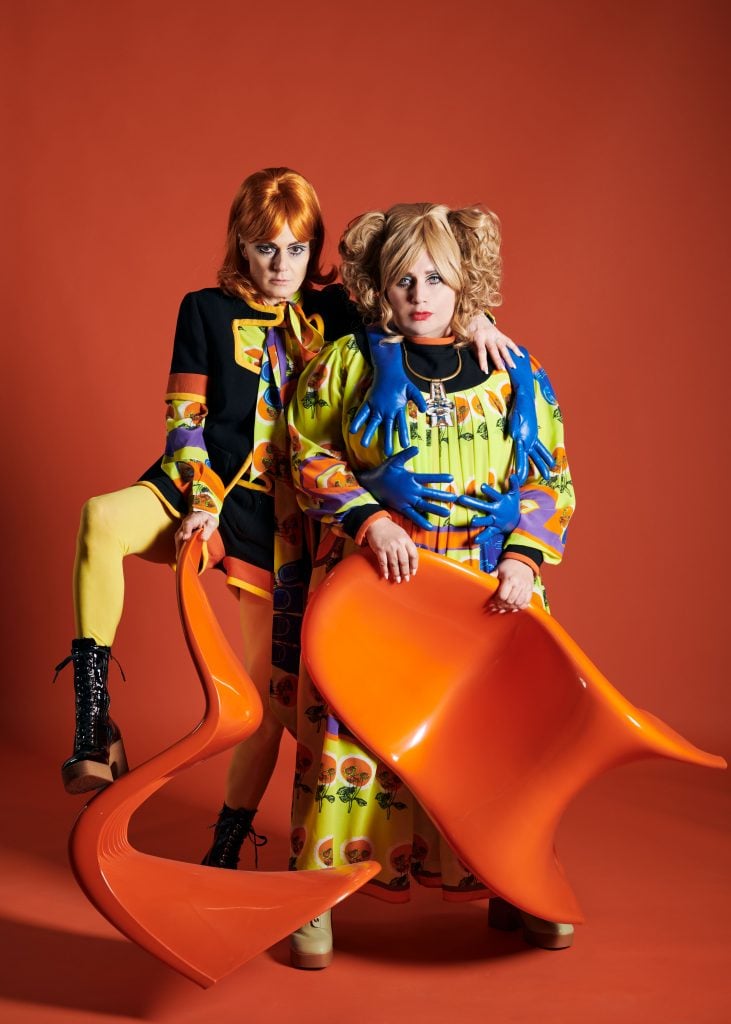
Jakob Lena Knebl and Ashley Hans Sheirl. Photo by Christian Benesch.
Across the pavilion, categorical distinctions collapse. Bodies are taken apart, and their parts twisted, magnified, fetishized, and decontextualized. Gender and sexual fluidity abound inside the “soft machine” of the pavilion, which itself—an idea influenced by Donna Haraway’s Cyborg Manifesto—becomes a creature in the duo’s post-gender, post-human, world. Sheirl, who began taking testosterone shots at age 40, has taken this idea beyond the theoretical and into the practical experiment of her/his own life.
A pioneer of the queer movement in the arts, Sheirl began working with moving image in the late 1970s, and has made more than 50 films including the transgender cult classic Dandy Dust, a camp sci-fi epic that follows a cyborg of fluid gender whose memory has been erased. Sheirl has been painting since the mid 1990s, and views the vibrant display element of the work in the biennale as something of a practice of expanded painting.
In Sheirl’s side of the pavilion, elements from the history of painting from photographical realism to abstraction are blended together on large panels, with three-dimensional objects cutting through the space. The installation is designed like a walk-in painting, with elements that remind you of theater backdrops or, as evidenced during my walk-through, a good spot to capture that perfect Venice Biennale Instagram shot.
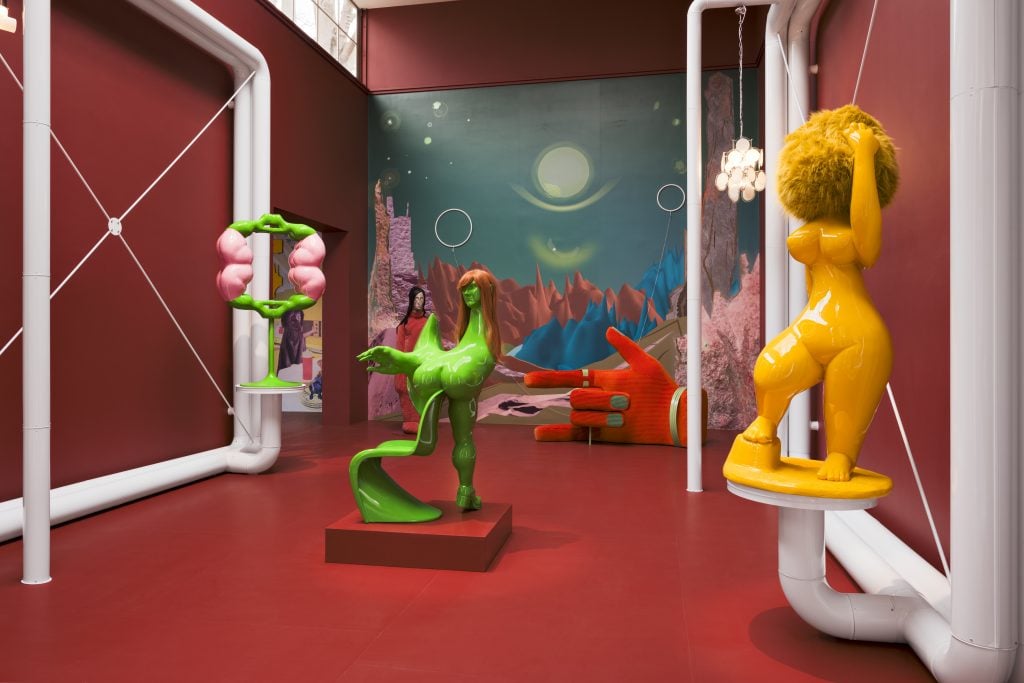
Installation view, Austrian Pavilion Biennale Arte 2022. Photo: Georg Petermichl; ©Jakob Lena Knebl and Ashley Hans Sheirl.
Knebl’s equally colorful side presents sculptures that offer their own hybrid of art historical forms, where Henry Moore bleeds into Botero, and then into a mould of her own face. The artist has a disregard for classical hierarchical distinctions between different art forms, and infuses elements of fashion and design into high art historical references. She also cross-pollinates discrete materials such as ceramics, leather, fiberglass and textile. Knebl worked for a decade in elderly care before coming to art—a background that might have shaped her no-nonsense approach.
Curator Marc-Olivier Wahler first met Knebl in 2018, and was so impressed by this approach that he gave her carte blanche for a very imaginative rehang of the permanent collection at MAH Geneva last year. The work “sheds light on the manner in which personal and collective identities might transform, renew and adapt depending on the environments the artist constructs,” Wahler told Artnet News.
For the curator, what is particular about Knebl’s work is that it creates a space apart from ontological hierarchies that shut down interdisciplinary dialogue. “It seems natural to us to grant different interpretations to a piece of conceptual art than to a decorative tapestry; we tend to look at a dining room table differently than we would an Aztec sculpture,” Wahler said. But work like Knebl’s levels those distinctions, and creates room for ideas to intersect.
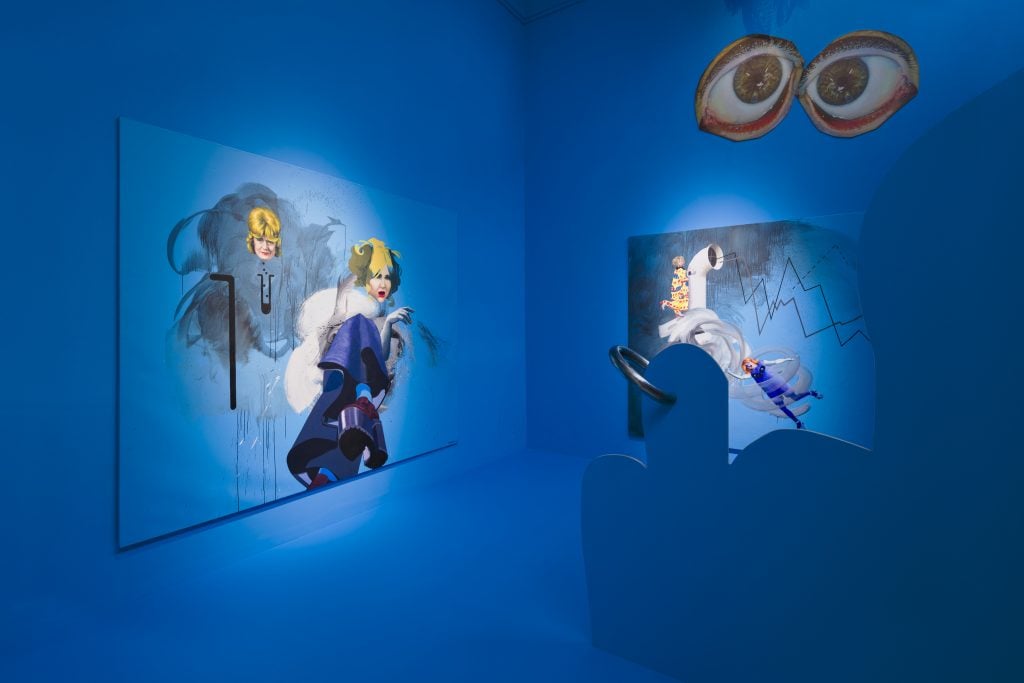
Installation view, Austrian Pavilion Biennale Arte 2022. Photo: Georg Petermichl; ©Jakob Lena Knebl and Ashley Hans Sheirl.
Knebl was first introduced to Scheirl’s work while a student of art and design, and she invited Sheirl to have her/his solo first exhibition in Austria at Knebl’s project space.
They became a couple more than 10 years ago, and while they have influenced each other’s lives and works since then, it wasn’t until the 2019 Lyon Biennial that they officially worked together as a duo on their first expansive installation. A year later, they mounted a joint exhibition at Kunsthaus Bregenz. The exhibition in Venice is their third big installation together.
The blending of ideas, materials, and forms within the artists’ multimedia installations is also what appealed to curator Karola Kraus, director of Vienna’s Mumok museum, who curated the pavilion in Venice. Kraus first encountered Knebl in Berlin in 2010, after she had designed a fashion collection for the Austrian artist Heimo Zobernig to mark the 20th anniversary of Galerie Christian Nagel. She became aware of Sheirl’s work later, in 2017, at Documenta 14 in Kassel and Athens, and paintings by Sheirl ended up making their way into her museum that same year, after she invited Knebl to rehang Mumok’s collection.
For Kraus, the duo’s contribution to art history lies in “the topicality and explosive nature of their themes, which they address in their multisensory works with broad appeal,” she told Artnet News. “Their works, characterized by manifold interweavings between art, performance, design, fashion and architecture, address current discourses of global relevance.”
Showing in a biennale in 2022 means that that context of global relevance involves constructing an identity against backdrops of climate change, the rise of nationalism and fascisms across the world, and the outbreak of war in Ukraine, among other realities. But the artists are unfazed by the pressure. “Times of upheaval can bring about strong work,” Scheirl said. “They pressure us to be even clearer about where we stand.”
Walking into the Austrian pavilion may feel a little like walking into an alternate dimension, but rather than an imaginary Arcadia or a dysfunctional reality, they’ve framed their pavilion as a “heterotopian” space, that is grounded in the realities that exist outside of it but where there is room for different ways of being and thinking. Its vision concerns “both utopias and dystopias, and questioning what kind of utopias and dystopias will be created,” Knebl explained. “It’s about the question: How do we want to live in the future? How is it possible to make our radius wider?”
As for their immediate future, the next big thing for the duo will be a solo exhibition at the Palais de Tokyo in Paris in 2023. One can only imagine what possible worlds they might carve open there.